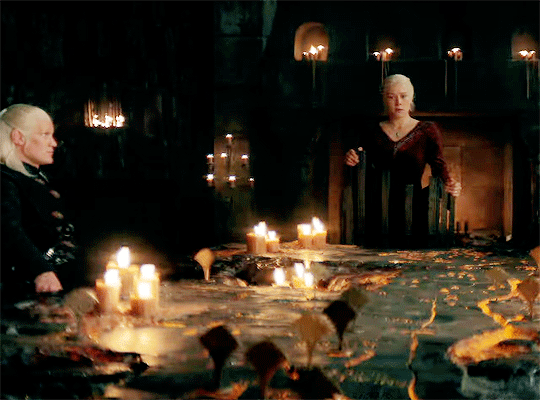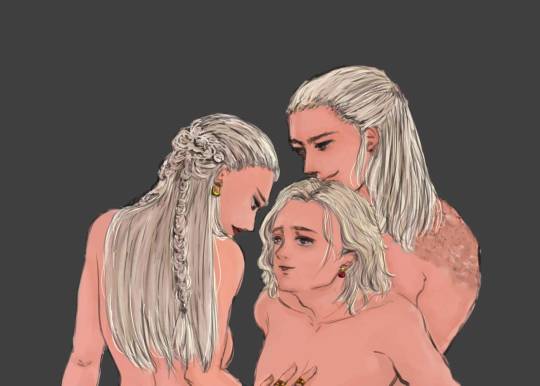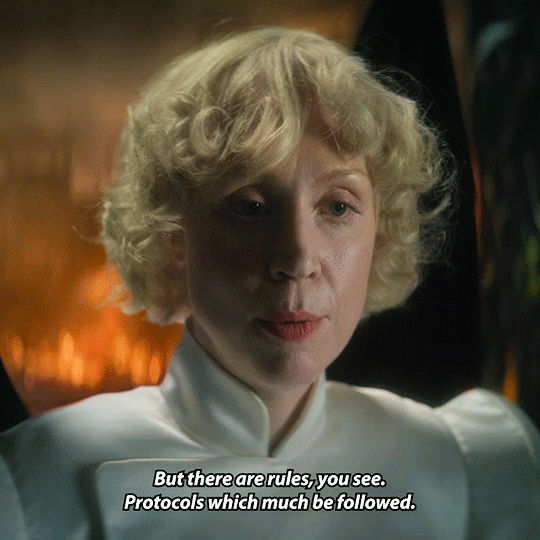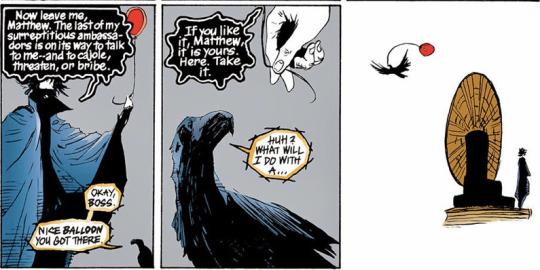Text






Rhaenyra in the House of the Dragon Season 2 | Official Teaser
207 notes
·
View notes
Text
The Women Surrounding a Medieval Queen
This goes through the different types of maids that would serve a Queen, as well as the different duties and function of companions or lady's in waiting
This is something i've had in docs as a personal reference forever. I'm putting it here so I can link it on discord, but please note NONE of this information is my own, it has all been collected from a dozen+ wikipedia pages.

Overview of Maid Types:
Maids traditionally have a fixed position in the hierarchy of the large households, and although there is overlap between definitions (dependent on the size of the household) the positions themselves would typically be rigidly adhered to. The usual classifications of maid in a large household are:
Lady's maid: a senior servant who reported directly to the lady of the house, but ranked beneath the housekeeper, and accompanied her lady on travel. She took care of her mistress's clothes and hair, and sometimes served as confidante.
.
House-maid or housemaid: a generic term for maids whose function was chiefly "above stairs", and were usually a little older, and better paid. Where a household included multiple housemaids, the roles were often subdivided as below.
.
Head house-maid: the senior house maid, reporting to the housekeeper. (Also called "house parlour maid" in an establishment with only one or two upstairs maids).
.
Parlour maid: they cleaned and tidied reception rooms and living areas by morning, and often served refreshments at afternoon tea, and sometimes also dinner. They tidied studies and libraries, and (with footmen) answered bells calling for service.
.
Chamber maid: they cleaned and maintained the bedrooms, ensured fires were lit in fireplaces, and supplied hot water.
.
Laundry maid: they maintained bedding and towels. They also washed, dried, and ironed clothes for the whole household, including the servants.
.
Under house parlour maid: the general deputy to the house parlour maid in a small establishment which had only two upstairs maids.
.
Nursery maid: also an "upstairs maid", but one who worked in the children's nursery, maintaining fires, cleanliness, and good order. Reported to the nanny rather than the housekeeper. The nursemaid would often stay with one family for years or as long as their services were needed.
.
Kitchen maid: a "below stairs" maid who reported to the cook, and assisted in running the kitchens.
Head kitchen maid: where multiple kitchen maids were employed, the "head kitchen maid" was effectively a deputy to the cook, engaged largely in the plainer and simpler cooking (sometimes cooking the servants' meals).
.
Under kitchen maid: where multiple kitchen maids were employed, these were the staff who prepared vegetables, peeled potatoes, and assisted in presentation of finished cooking for serving.
.
Scullery maid: the lowest grade of "below stairs" maid, reporting to the cook, the scullery maids were responsible for washing cutlery, crockery, and glassware, and scrubbing kitchen floors, as well as monitoring ovens while kitchen maids ate their own supper.
.
Between maid, sometimes known as a "tweeny": roughly equivalent in status to scullery maids, and often paid less, between maids in a large household waited on the senior servants (butler, housekeeper, and cook) and were therefore answerable to all three department heads, often leading to friction in their employment.
.
Still room maid: a junior maid employed in the still room; as the work involved the supply of alcohol, cosmetics, medicines, and cooking ingredients across all departments of the house, the still room maids were part of the "between staff", jointly answerable to all three department heads.
A Closer Look
A lady's companion was a woman of genteel birth who lived with a woman of rank or wealth as retainer. Where ladies-in-waiting were usually women from the most privileged backgrounds who took the position for the prestige of associating with royalty, or for the enhanced marriage prospects available to those who spent time at court, a lady's companions usually took up their occupation because they needed to earn a living and have somewhere to live. A companion is not to be confused with lady's maid.
Like a governess, a lady's companion was not regarded as a servant, but neither was she really treated as an equal; however her position in the household of her employer was notably less awkward and solitary than that of a governess. Only women from a class background similar to or only a little below that of their employer would be considered for the position.
The companion's role was to spend her time with her employer, providing company and conversation, to help her to entertain guests and often to accompany her to social events. In return she would be given a room in the family's part of the house, rather than the servants' quarters; all of her meals would be provided, and she would eat with her employer; and she would be paid a small salary, which would be called an "allowance" – never "wages".
She would not be expected to perform any domestic duties which her employer might not carry out herself, in other words little other than giving directions to servants, fancy sewing and pouring tea. Thus the role was not very different from that of an adult relation in respect of the lady of a household, except for the essential subservience resulting from financial dependency.
Lady's companions were employed because upper- and middle-class women spent most of their time at home. A lady's companion might be taken on by an unmarried woman living on her own, by a widow, a married woman who lived with her husband and sons but had no daughters and desired female company, or by an unmarried woman who was living with her father or another male relation but had lost her mother, and was too old to have a governess.
In the last case the companion would also act as a chaperone; at the time, it would not have been socially acceptable for a young lady to receive male visitors without either a male relation or an older lady present (a female servant would not have sufficed).

A lady's maid is a female personal attendant who waits on her female employer. The role of a lady's maid is similar to that of a gentleman's valet.
Traditionally, the lady's maid was not as high-ranking as a lady's companion, who was a retainer rather than a servant, but the rewards included room and board, travel and somewhat improved social status. In the servants' hall, a lady's maid took precedence akin to that of her mistress.
In Britain, a lady's maid would be addressed by her surname by her employer, while she was addressed as "Miss" by junior servants or when visiting another servants' hall.
A lady's maid's specific duties included helping her mistress with her appearance, including make-up, hairdressing, clothing, jewellery, and shoes.
A lady's maid would also remove stains from clothing; sew, mend, and alter garments as needed; bring her mistress breakfast in her room; and draw her mistress's bath. However, she would not be expected to dust and clean every small item, as that would be the job of a housemaid.

A maid, housemaid, or maidservant were once part of an elaborate hierarchy in great houses, where the retinue of servants stretched up to the housekeeper and butler, responsible for female and male employees respectively.
The word "maid" itself means an unmarried young woman or virgin. Domestic workers, particularly those low in the hierarchy, such as maids and footmen, were expected to remain unmarried while in service

"What the fuck is a lady in waiting, then?"
A lady-in-waiting is a female personal assistant at a court, attending on a royal woman or a high-ranking noblewoman. Historically, in Europe, a lady-in-waiting was often a noblewoman but of lower rank
A lady-in-waiting was considered more of a secretary, courtier, or companion to her mistress than a servant.
In some other parts of the world, the lady-in-waiting, often referred to as palace woman, was in practice a servant or a slave rather than a high-ranking woman though they had the same duties. In courts where polygamy was practised, a court lady was formally available to the monarch for sexual services, and she could become his wife, consort, courtesan, or concubine.
The duties of ladies-in-waiting at the Tudor court were to act as companions for the queen, both in public and in private. They had to accompany her wherever she went, to entertain her with music, dance or singing and to dress, bathe and help her use the toilet, since a royal person, by the standards of the day, was not supposed to do anything for herself, but was always to be waited upon in all daily tasks as a sign of their status.
Other functions historically discharged by ladies-in-waiting included proficiency in the etiquette, languages, dances, horse riding, music making, and painting prevalent at court; keeping her mistress abreast of activities and personages at court; care of the rooms and wardrobe of her mistress; secretarial tasks; supervision of servants, budget and purchases; reading correspondence to her mistress and writing on her behalf; and discreetly relaying messages upon command.
Ladies-in-waiting were appointed because of their social status as members of the nobility, on the recommendation of court officials, or other prominent citizens, and because they were expected to be supporters of the royal family due to their own family relationships. When the queen was not a foreigner, her own relations were often appointed as they were presumed to be trustworthy and loyal.
The ladies-in-waiting were headed by the mistress of the robes, followed in rank by the first lady of the bedchamber, who supervised the group of ladies of the bedchamber (typically wives or widows of peers above the rank of earl), in turn followed by the group of women of the bedchamber (usually the daughters of peers) and finally the group of maids of honour.
Ok here is where it gets confusing
First Lady of the Bedchamber is the title of the highest of the ladies of the bedchamber, those holding the official position of personal attendants on a queen or princess. The position is traditionally held by a female member of a noble family.
Lady of the Bedchamber is the title of a lady-in-waiting holding the official position of personal attendant on a British queen regnant or queen consort.
The Maid of the Bedchamber was an office of high status selected from nobility. She had often been a maid of honour before she was promoted, because of birth or royal favor. Her tasks were essentially the same as the tasks of the maids of honour, though they were of higher status.
A maid of honour is a junior attendant of a queen in royal households.
The position was and is junior to the lady-in-waiting.
Traditionally, a queen regnant had eight maids of honour, while a queen consort had four; Queen Anne Boleyn, however, had over 60.
A maid of honour was a maiden, meaning that she had never been married (and therefore was ostensibly a virgin), and was usually young and a member of the nobility.
The mistress of the robes was the senior lady in the household who would, by appointment, attend on the Queen (whether queen regnant or a queen consort). Queens dowager retained their own mistresses of the robes. (In the 18th century Princesses of Wales had one too).
Initially responsible for the queen's clothes and jewellery (as the name implies), the post-holder latterly had the responsibility for arranging the rota of attendance of the ladies-in-waiting on the queen, being in attendance herself on more formal occasions, and undertaking duties at state ceremonies.
During the 17th and 18th centuries, this role often overlapped with or was replaced as first lady of the bedchamber. In modern times, the mistress of the robes was almost always a duchess.

A brief overview of a medieval household and the male/king's equivalents.
41 notes
·
View notes
Text







(mostly) intl audience: *watching for the main couple*
me: *watching for meng yanchen + his hands*
(this is what i've been up to recently because right now 我缺宇啊 你的好6什么时候播呢 T^T)
anyway congrats wei daxun your years of acting + variety paid off!!! and you've graced us with all these shots goddamn



你的美确实令人羡慕,遭人妒忌,让人憎恶哈哈哈哈 this was a pointless post but hahahahaha too good not to share. always liked his presence in variety but finally!!!!
8 notes
·
View notes
Text
another version of this au, where aemond plays revenge game
lucemond shared a bed right before the wedding. aemond was very persistent in his desire, so luke, trusting the alpha, agreed to spend the night together.
standing in front of the septon, aemond stops the wedding ceremony. all the courtiers are confused, as is lucerys. alpha moves away from luke with a cold expression and says loudly, “i can't marry this omega because i doubt his maidenhead.” the crowd starts whispering. luke feels panic and pulling pain in his chest. aemond’s voice is heard as if through water. “i want maesters to inspect him and give their verdict."
viserys, rhaenyra and alicent try to stop it, but they surrender under courtiers’ onslaught. lucerys has nothing to hide anyway, right? it’s just a formality.
luke understands that he won’t pass the inspection. his whole body is strewn with bites and bruises. maesters’d announce this in the court, the wedding’d be canceled, and he’d spend the rest of his days alone at the dragonstone labeled as bastard and whore.
was it all a lie, was it such a twisted revenge, did i really deserve it, omega thinks. some guard take him by the arms, ready to escort him to the maesters’ room. lucerys finally takes his eyes off the floor and meets alpha’s unfamiliar gaze, full of hatred and mockery.
aemond says in his nephew’s ear, “do you really think i would ever want to marry you? an eye for an eye.”
343 notes
·
View notes
Text
This man straight up had tear tracks on his face while walking towards his execution coronation

5K notes
·
View notes
Text
Lucerys is his mother’s son bc he’s got a thing for his uncle (aemond), Jace is his mothers son bc he has a harem (cregan, aegon, baela)
216 notes
·
View notes
Text
"I have no wish to be King. Wed me, sister, in the tradition of our House. Take me as your second consort, as my namesake once had done."

230 notes
·
View notes
Text

#daemyra#daegonyra#daegon#rhaegon#hotd smut#daemyra and their crybaby little meow meow#queen rhaenyra and her 'fuck you I am gonna have two dicks' era#daemon targaryen#rhaenyra targaryen#aegon targaryen#house of the dragon#house targaryen
229 notes
·
View notes
Text

#house targaryen#house of the dragon#daemyra#rhaegon#daegon#daegonyra#NP#rhaenyra targaryen#daemon targaryen#hotd aegon#aegon the second
119 notes
·
View notes
Text
i cannot fucking wait to see rhaenyra being crowned.
despite everything, she gets crowned with the crown that was her father's, the one made for her great-grandfather.
she gets crowned by daemon, her blood and flesh, her uncle and husband, her sworn sword and king consort.
she gets crowned in dragonstone, in her family seat, all black volcanic rock and dragons surrounding — the closest thing the targaryens have to valyria.
she gets crowned amongst the blacks, her family, her loyal supporters, the people that will fight and die for her.
she gets crowned as queen rhaenyra targaryen, first of her name, queen of the andals, the rhoynar and the first men, lady of the seven kingdoms — the only title she is not given is 'protector of the realm' which is claimed by daemon himself.
rhaenyra claims the title of the realm — but she has always been the realm: first as princess, then as heir.
daemon claims the title of the protector of the realm — but he has always been her protector: first as uncle, then as husband.
3K notes
·
View notes
Text

69 notes
·
View notes
Text
Dream's subtle, sarcastic smiles throughout this episode are great. He finds their passive aggressiveness quite amusing.








And finally, this.

"Of course they change into the fancy shiny leather battle gear. They'd never pass up on that opportunity."
14K notes
·
View notes
Photo










Robert Pattinson as Batman in THE BATMAN (2022)
Tom Sturridge as Sandman in THE SANDMAN (2022)
15K notes
·
View notes











